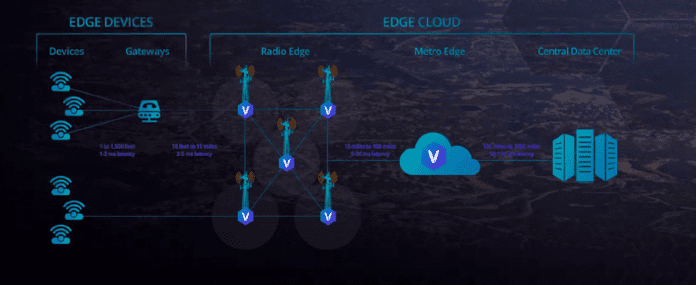A Crown Castle distributed antenna system in Chicago is the site of a new data center architecture that could change the economics of centralized radio access networks. Vapor IO, a startup funded by Crown Castle and supported by Intel, says its Kinectic Edge architecture will cut data center costs to less than $4 million per megawatt and will enable operators to share radio edge data center resources in much the same way that they share cell towers and DAS headends.
Vapor IO says its modular data center is unique in its ability to support colocation deployment models. Its “vapor chamber” is a round rack enclosure system that operates like a turntable, with six racks around a central hot aisle. Each rack supports up to four tenants, for a total of 24 possible tenants per center.
“Verizon and AT&T could be on different racks and they would never get to one another’s gear,” explained Vapor IO founder and CEO Cole Crawford.
Crawford expects carrier customers to occupy server racks at several locations within a city, using what he calls “hardware disaggregation” to increase network resiliency without the need for expensive backup generators. He said Vapor IO’s architecture can also eliminate the need for dedicated HVAC systems because it uses a software-and-sensor-controlled fan to pull air from the surrounding room and pass it through the racks to cool the equipment.
The Chicago data center leverages existing structural facilities and fiber, and Vapor IO CEO Cole Crawford said this is one deployment model for the company’s Kinetic Edge architecture, which can be integrated into existing data center environments. The modular data center is also designed to sit on simple slab in a pre-fabricated structure at the base of a cell tower. The entire data assembly can be transported by a trailer, and Vapor IO claims the system can be deployed in one day.
Network edge deployments are seen as the primary use case by Crawford, who was founding executive director of the Open Compute Project Foundation before founding Vapor IO. He started Vapor IO to integrate wired and wireless networks as operators find themselves processing more and more network data. 5G networks and the internet of things are set to increase the data load exponentially.
“We’ll have smart clothes, we’ll have smart shoes, we’ll have sensors built into autonomous cars and drones, etc, and that’s a far more mobile internet,” said Crawford. He sees the radio edge as the nexus of data processing.
“The edge native applications that we see being deployed out in these types of environments will be assisted through the telemetry that we allow for both applications and container orchestration technologies like Mesos or Kubernetes or OpenStack,” Crawford said.
Crawford believes data center co-location will increase efficiency and accelerate network interactions. Each “vapor chamber” includes a “meet-me room” that allows for physical cross-connects. This local breakout terminates and routes IP addresses at the site, eliminating fiber costs and bringing latencies to below 10 milliseconds, Crawford said.
The vapor chamber uses software to authenticate tenants, eliminating the need for data center security guards. When tenants authenticate at the front door, the turntable moves and presents the user’s rack.
Crawford believes the real value of modular data centers will emerge as companies invest in multiple deployments and connect them. He foresees virtual data centers spanning entire cities, and delivering record-breaking levels of availability.
Vapor IO calls Chicago its “first Kinetic Edge city,” suggesting that more installations may be on the horizon. Deployments are likely to follow Crown Castle’s tower and DAS footprint, since Vapor IO offers the same shared infrastructure model that Crown uses. Crawford foresees modular data centers creating “the same economics at the bottom of the tower as at the top.”

